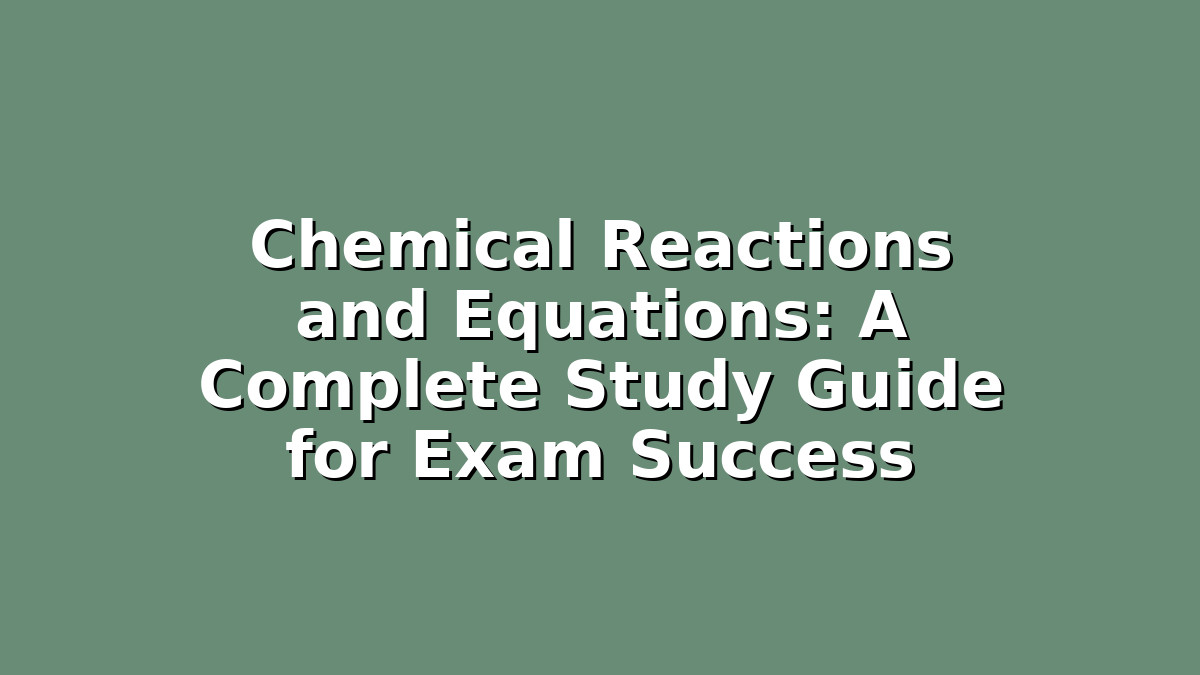Preparing for exams can be stressful, especially when it comes to subjects like Chemistry. One of the fundamental topics students often encounter is chemical reactions and equations. Understanding these concepts not only helps you grasp the basics of chemistry but also builds a strong foundation for more advanced topics. In this comprehensive guide, we’ll break down chemical reactions and equations, provide effective study tips, and share strategies to help you excel in your exams.
Understanding Chemical Reactions: The What and Why
Chemical reactions are processes where substances, called reactants, transform into new substances known as products. This transformation involves making and breaking chemical bonds, resulting in changes in composition and properties. For example, when hydrogen reacts with oxygen, water is formed — a simple but essential chemical reaction.
Why is it important to learn about chemical reactions?
– Foundation of Chemistry: All chemical processes, from digestion to respiration and combustion, involve chemical reactions.
– Exam Focus: Many exam questions revolve around identifying, balancing, and understanding reactions.
– Practical Applications: Knowledge of chemical reactions is essential for real-life applications in medicine, industry, and environmental science.
To truly master chemical reactions, it’s crucial to understand their types, characteristics, and how to represent them through chemical equations.
—
Section 1: Types of Chemical Reactions and How to Identify Them
Before you can write or balance chemical equations, you need to know the common types of chemical reactions. Recognizing reaction types helps you predict products and solve problems faster.
1. Combination (Synthesis) Reactions
Two or more reactants combine to form a single product.
Example:
[ 2H_2 + O_2 rightarrow 2H_2O ]
2. Decomposition Reactions
A single compound breaks down into two or more simpler substances.
Example:
[ 2HgO rightarrow 2Hg + O_2 ]
3. Displacement Reactions
One element replaces another element in a compound.
Example (Single Displacement):
[ Zn + 2HCl rightarrow ZnCl_2 + H_2 ]
4. Double Displacement Reactions
Exchange of ions between two compounds forming two new compounds.
Example:
[ AgNO_3 + NaCl rightarrow AgCl + NaNO_3 ]
5. Combustion Reactions
A substance combines with oxygen, releasing energy as heat and light.
Example:
[ CH_4 + 2O_2 rightarrow CO_2 + 2H_2O ]
Study Tip: Create Flashcards to Memorize Reaction Types
Make flashcards with each reaction type on one side and definitions plus examples on the other. Review these regularly. This active recall method helps reinforce memory and quick recognition during exams.
—
Section 2: Mastering Chemical Equations – Writing and Balancing
Once you understand the types of reactions, the next step is to write chemical equations — symbolic representations of chemical reactions. An equation shows reactants and products with correct chemical formulas.
Writing Chemical Equations
– Identify reactants and products.
– Write correct chemical formulas for each substance.
– Use an arrow to show the direction of the reaction.
Balancing Chemical Equations
Balancing means making sure the number of atoms for each element is the same on both sides of the equation. This follows the law of conservation of mass, which states matter cannot be created or destroyed in a reaction.
Steps to Balance Equations:
1. Write the unbalanced equation.
2. Count the atoms of each element on both sides.
3. Adjust coefficients (numbers before compounds) to balance atoms.
4. Repeat until all elements are balanced.
5. Double-check your work.
Example: Balance the combustion of propane:
Unbalanced: [ C_3H_8 + O_2 rightarrow CO_2 + H_2O ]
Balanced: [ C_3H_8 + 5O_2 rightarrow 3CO_2 + 4H_2O ]
Study Tip: Practice with Worksheets and Past Papers
Balancing equations requires practice. Use available worksheets or past exam questions to try different types of equations. Set a timer to simulate exam conditions, improving both speed and accuracy.
—
Section 3: Effective Study Strategies for Chemical Reactions and Equations
To excel in chemistry, especially chemical reactions and equations, you need an effective study plan that combines understanding with practice.
1. Conceptual Understanding First
Don’t just memorize formulas and reactions. Take time to understand why reactions happen, how atoms rearrange, and the significance of balancing equations. Use visual aids like diagrams and molecular models to enhance comprehension.
2. Use Mnemonics and Memory Tricks
For example, to remember the diatomic molecules (H₂, N₂, O₂, F₂, Cl₂, Br₂, I₂), use the mnemonic: “Have No Fear Of Ice Cold Beer.” These molecules often appear in reaction questions.
3. Group Study and Teaching Others
Explain reaction types and balancing techniques to classmates or friends. Teaching is a powerful way to reinforce your knowledge and identify gaps.
4. Regular Revision
Chemistry is cumulative. Schedule short, frequent revision sessions rather than long, infrequent ones. Use spaced repetition techniques to ensure long-term retention.
5. Solve Application-Based Questions
Many exams test application, not just theory. Try questions that require you to predict products, balance equations, or explain reaction types in context.
Study Tip: Utilize Online Resources and Videos
Platforms like Khan Academy, YouTube channels, and educational apps offer visual demonstrations of chemical reactions and balancing. These can be extremely helpful if you’re a visual learner.
—
Conclusion
Chemical reactions and equations are fundamental topics in chemistry that can seem challenging at first but become manageable with the right approach. By understanding reaction types, mastering equation writing and balancing, and adopting effective study strategies, you can boost your confidence and improve your exam performance.
Remember, success in chemistry comes from consistent practice and a clear conceptual understanding. Break down complex topics into smaller parts, use active learning techniques, and don’t hesitate to seek help when needed. With dedication and the right resources, chemical reactions and equations will no longer be a hurdle but a stepping stone to your academic success.
Good luck with your studies!
—

Responses